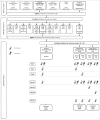Four-year antibody persistence and response to a booster dose of a pentavalent MenABCWY vaccine administered to healthy adolescents and young adults
- PMID: 29601256
- PMCID: PMC5989907
- DOI: 10.1080/21645515.2018.1457595
Four-year antibody persistence and response to a booster dose of a pentavalent MenABCWY vaccine administered to healthy adolescents and young adults
Abstract
This open-label, multicenter extension study (NCT02451514) assessed persistence of Neisseria meningitidis serogroups ABCWY antibodies 4 years after primary vaccination. Adolescents and young adults who previously received 2 doses of MenABCWY+OMV (Group III), 1 dose of MenACWY-CRM (Group VI), or newly-recruited vaccine-naïve participants (Group VII) were administered 1 (Group III) or 2 doses (Groups VI and VII) of MenABCWY+OMV, 1 month apart. Immunogenicity was assessed by human serum bactericidal assay (hSBA). Safety and reactogenicity were also evaluated. Percentages of participants with hSBA titers ≥8 (serogroups ACWY), ≥5 (serogroup B) and hSBA geometric mean titers (GMTs) were evaluated in all 129 enrolled participants (Group III: 33; Group VI: 46; Group VII: 50). Anti-ACWY antibody concentrations waned over 4 years post-vaccination, but remained above pre-vaccination concentrations. Similarly, levels of antibodies against serogroup B test strains also waned over 4 years post-vaccination, but remained above pre-vaccination concentrations for some strains. MenABCWY+OMV booster induced a robust anamnestic anti-ACWY response in Group III and VI and a good response against serogroup B test strains (≥82%) in Group III. In serogroup B-naïve participants (Groups VI and VII), anti-B responses to 2 doses of MenABCWY+OMV were less homogenous and lower than in Group III. MenABCWY+OMV was reactogenic, but well-tolerated. No safety concerns were identified. These findings indicate that although antibodies against N. meningitidis serogroups ABCWY waned over 4 years post-vaccination, exposure to a MenABCWY+OMV booster dose elicits an anamnestic response in adolescents previously exposed to the same or another multivalent meningococcal vaccine.
Keywords: MenABCW; MenACWY; antibody persistence; booster dose; meningococcal vaccine.
Figures




Similar articles
-
Immunogenicity and safety of a pentavalent meningococcal ABCWY vaccine in adolescents and young adults: an observer-blind, active-controlled, randomised trial.Lancet Infect Dis. 2023 Dec;23(12):1370-1382. doi: 10.1016/S1473-3099(23)00191-3. Epub 2023 Aug 11. Lancet Infect Dis. 2023. PMID: 37579773 Clinical Trial.
-
Breadth of immune response, immunogenicity, reactogenicity, and safety for a pentavalent meningococcal ABCWY vaccine in healthy adolescents and young adults: results from a phase 3, randomised, controlled observer-blinded trial.Lancet Infect Dis. 2025 May;25(5):560-573. doi: 10.1016/S1473-3099(24)00667-4. Epub 2024 Dec 5. Lancet Infect Dis. 2025. PMID: 39647494 Clinical Trial.
-
A comparative evaluation of two investigational meningococcal ABCWY vaccine formulations: Results of a phase 2 randomized, controlled trial.Vaccine. 2015 May 15;33(21):2500-10. doi: 10.1016/j.vaccine.2015.03.001. Epub 2015 Mar 17. Vaccine. 2015. PMID: 25795256 Clinical Trial.
-
Persistence of the immune response after MenACWY-CRM vaccination and response to a booster dose, in adolescents, children and infants.Hum Vaccin Immunother. 2016 May 3;12(5):1300-10. doi: 10.1080/21645515.2015.1136040. Epub 2016 Feb 1. Hum Vaccin Immunother. 2016. PMID: 26829877 Free PMC article. Review.
-
Progress toward the global control of Neisseria meningitidis: 21st century vaccines, current guidelines, and challenges for future vaccine development.Hum Vaccin Immunother. 2018 May 4;14(5):1146-1160. doi: 10.1080/21645515.2018.1451810. Epub 2018 May 9. Hum Vaccin Immunother. 2018. PMID: 29543582 Free PMC article. Review.
Cited by
-
Effect of complement Factor H on antibody repertoire and protection elicited by meningococcal capsular group B vaccines containing Factor H binding protein.Hum Vaccin Immunother. 2020 Mar 3;16(3):703-712. doi: 10.1080/21645515.2019.1664241. Epub 2019 Oct 22. Hum Vaccin Immunother. 2020. PMID: 31526219 Free PMC article.
-
A comparison of national vaccination policies to prevent serogroup B meningococcal disease.Vaccine. 2022 Jun 9;40(26):3647-3654. doi: 10.1016/j.vaccine.2022.04.101. Epub 2022 May 14. Vaccine. 2022. PMID: 35581099 Free PMC article. Review.
-
Bioengineering Strategies for Developing Vaccines against Respiratory Viral Diseases.Clin Microbiol Rev. 2022 Jan 19;35(1):e0012321. doi: 10.1128/CMR.00123-21. Epub 2021 Nov 17. Clin Microbiol Rev. 2022. PMID: 34788128 Free PMC article. Review.
-
Vaccines against Meningococcal Diseases.Microorganisms. 2020 Oct 3;8(10):1521. doi: 10.3390/microorganisms8101521. Microorganisms. 2020. PMID: 33022961 Free PMC article. Review.
-
Immunogenicity and safety of different schedules of the meningococcal ABCWY vaccine, with assessment of long-term antibody persistence and booster responses - results from two phase 2b randomized trials in adolescents.Hum Vaccin Immunother. 2021 Nov 2;17(11):4689-4700. doi: 10.1080/21645515.2021.1968214. Epub 2021 Sep 28. Hum Vaccin Immunother. 2021. PMID: 34582323 Free PMC article. Clinical Trial.
References
-
- European Centre for Disease Prevention and Control Surveillance of invasive bacterial diseases in Europe 2007. [accessed February14, 2018]. http://www.ecdc.europa. eu/en/publications/Publications/101011_SUR_Surve....
Publication types
MeSH terms
Substances
LinkOut - more resources
Full Text Sources
Other Literature Sources
Medical
